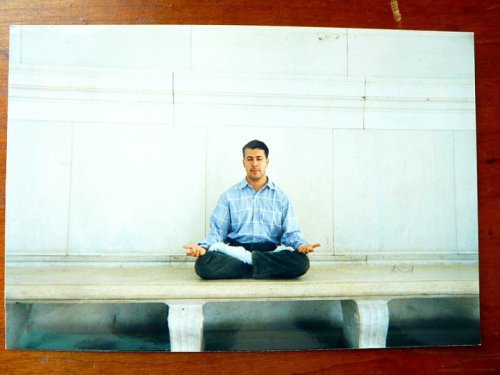THE MINDFULNESS MEDITATION.
MINDFULNESS MEDITATION.
Mindfulness Meditation is one of the two main types of Meditations that are popular in Insight Meditation, a form of Buddhism that has been helpful to me. The other one is Lovingkindness, which is also detailed in these Notes. They are non-religious, non-dogmatic meditations which are focused on practical results for every person.
Mindfulness Training, more than anything else, helped me to first slow, and then absolutely halt my very severe anxiety, episodes of which I detail in my book, How To Be Relentlessly Happy. It is a deceptively simple meditation that can have, and has had, very profound effects on many an anxious or troubled persons mental state. Like chess, it takes only a minute to learn but can take some time to master.
You can do this meditation anywhere, at any time during the day. It does not require you to be on a special cushion at a certain time of day in front of a sacred image.
Like all meditation, keep with it, the effects are always cumulative. Just like muscle-training at the gym, don’t expect dramatic results in one sitting, but over time. Also, similarly to the gym, it matters how often you try, not how long you’re in. Better to meditate ten minutes a day for 100 days than to do an hour once and then stop for years.
The three steps of Mindfulness Meditation are:
1. Slow down or STOP.
2. Choose a PRIMARY OBJECT.
3. Take MENTAL NOTATIONS.
Step One;
If you cannot stop, take the initiative to slow down. Even this level of awareness “I’m going to slow down now”, is a change from our usual harried, moment to moment daily-life. Awareness is already coming in with this step. Slowing down, more than anything else, implies a mental slowing-down, where you arrest the thinking process from a chaos, into a singularly-directed path, with, if not a destination, a general direction, which brings us to step two.
Step Two;
Choose a primary object. This is something to focus ON, and to bring your attention back to, repeatedly. Students usually choose the breath, but other good ones could be; sounds (sounds of traffic, the ring of a bell, nearly any sound), the light of a candle, a mandala or other sacred image, anything you have a positive and non-complicated relationship to. Your attention will stray from your primary-object and that is natural. The important thing is to come back to the primary-object, repeatedly.
Step Three;
Take mental notations. These are, above all, non-judgmental notations, and sound like this … “now feeling hungry, now feeling anxious, now feeling bored, now feeling hungry again, now feeling excited, now feeling … ” and on, and on, similarly describing thoughts or feelings. Keep them short, just the most basic notations, and again, leave them non-judged,
“Now feeling hungry .. that is bad, I’m still struggling with my weight ..” would be incorrect.,
Merely note, “now feeling hungry, now feeling disappointed , now feeling ..”
-would be the correct version of that exact thought-sequence. If you are with the same thought or feeling in a continual way, note that as well like; “Now feeling hungry … now feeling hungry .. feeling hungry ..”
-check in every ten seconds or so, and merely note that it changes, when it changes, and it will change.
Results.
Why do this? There are many, good, long books on why this meditation works. Read them if you’d enjoy that or like that. The short version is that the mind very quickly starts to notice the following …
1. How many thoughts and feelings it HAS.
2. How frequently they change.
3. How it never truly identifies or permanently merges with any ONE state.
This is all very good for the mind to learn. And it learns that in an empirical way, though the *experience*, over time, of the meditation. That is very different from merely understanding this in theory, on an intellectual level where one might think, “of course, I know this already.” There are a lot of things we know in theory-that we haven’t experienced. Experience helps us to know something intimately.
When you know something is true, because you’ve lived it in that moment, it goes much deeper than the mind.This is helpful in innumerable ways. A lot of times our worst stretches of hours and days are when we are overly-identified in one state. When we realize just how many thoughts and feelings we do have, even within that state, then each one will start to have less hold over us and we are a lot less likely to be bullied around by our passing moods. We achieve a base-level of awareness, which is near to calm.
We realize that we are not solely our thoughts and feelings, but something much more, a bright spot of awareness.
Something that can happen in this meditation at some point is when the practitioner loses, quite by accident, focus on both the primary object and the mental notations. Thoughts stop and the mind is supremely restive. This is called bliss. The student doesn’t try for this state, but it can happen on its own, quite wonderfully at some point.
Any questions as always, reach out in the comments.
I’ve had great success with this simple and transformative meditation and many others have as well.
This is my version of a meditative practice extremely popular in Buddhism, and if you like it, you might enjoy reading other versions as well. My emphasis here was on brevity, practicality, results.
For a great primary-object, you might try the “breath of fire”, popular among yoga practitioners for a breath-technique.
As with all of my original writings I post, feel free to print them out, and share them.
Warmly, Troy.

Leave a comment